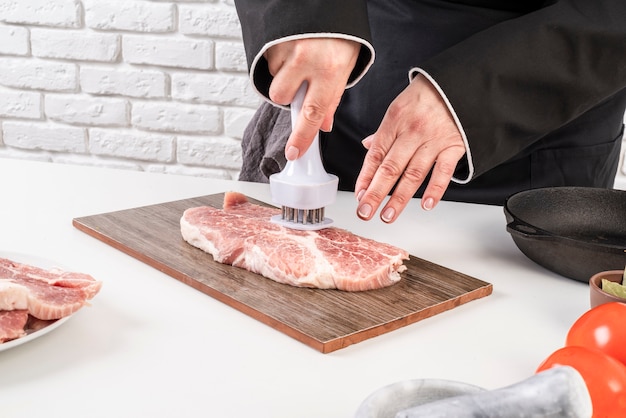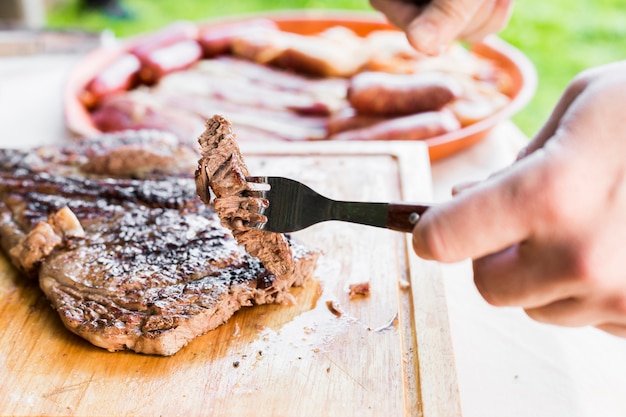Ah, steak. The very word conjures up images of perfectly seared, juicy, and flavorful meat, the kind that makes you close your eyes and savor every bite. Mastering the art of steak cooking is a journey, one that I've been on for years, filled with both glorious triumphs and some rather embarrassing mishaps (we'll just say those overcooked, rubbery disasters are a thing of the past).
This guide is your personal roadmap to achieving steak perfection. From picking the ideal cut to mastering different cooking methods and crafting those finishing touches that elevate your steak to culinary stardom, we'll cover it all. Grab your apron, sharpen those knives, and get ready for a delicious adventure!
(Part 1) Choosing Your Weapon: The Steak

Think of this as choosing the perfect weapon for a culinary battle. You want a cut that's up to the task, one that delivers both flavor and tenderness.
choosing the right cut
Navigating the world of steak cuts can feel like walking through a minefield. There are so many options, each with unique characteristics. But don't worry, I'll be your guide:
Rib-eye: This is the king, the undisputed champion. Its marbling (those beautiful streaks of fat) translates to an incredibly juicy and flavorful steak. Yes, it might be a bit pricier, but it's worth every penny.
new york strip: A classic choice known for its balanced flavor and slightly leaner profile than its rib-eye cousin. It's a versatile option for a range of cooking methods.
filet mignon: This cut is all about tenderness. It's the epitome of elegance, perfect for those who prefer a delicate flavor. Just be aware that it can be pricey and doesn't have the same robust flavor as other options.
Sirloin: A great value choice that offers a good balance of flavor and tenderness. It's a fantastic cut to experiment with different cooking techniques.
flank steak: This leaner cut is best for grilling or slicing thinly for stir-fries. Its flavor intensifies when marinated.
Getting to Know Your Butcher
There's something truly special about a relationship with your local butcher. They're your meat whisperers, experts in all things steak. Don't be afraid to ask questions, they love to share their knowledge. They can advise you on the best cuts, how to age your meat for maximum flavor, and even suggest some delicious recipes.
Choosing the Perfect Steak
Once you've settled on a cut, it's time to select the perfect steak. Here's what to look for:
Marbling: Those beautiful streaks of fat are crucial for a juicy and tender steak. The more marbling, the better.
Color: A fresh steak should have a vibrant, deep red color. Avoid steaks that are dull or discolored.
Texture: The steak should be firm and springy to the touch, not soft or mushy.
Smell: Fresh steak should have a clean, slightly sweet smell. Avoid any steaks that have a pungent or ammonia-like odor.
(Part 2) Preparing for Battle: Pre-Steak Rituals

You've got your perfect steak. Now, it's time to set the stage for the cooking process. These pre-cooking steps are essential for achieving that perfect steak.
The Art of Patting Dry
Patting your steak dry with kitchen paper might seem like a simple step, but it's a crucial one. A wet steak will steam instead of sear, resulting in a lackluster crust. You want a sizzling sound, not a quiet hiss!
Seasoning: The Secret Weapon
Now for the fun part: seasoning. This is where you truly personalize your steak. I'm a firm believer in keeping things simple with salt and pepper, but feel free to experiment.
My Personal Tip: Generously season both sides of the steak and allow it to sit at room temperature for about 30 minutes before cooking. This gives the meat a chance to warm up and allows the seasoning to penetrate for more intense flavor.
The Importance of Resting
Resist the urge to rush! Let your steak rest for at least 30 minutes at room temperature before cooking. This allows it to relax and even out its temperature. It might seem counterintuitive, but it's a game-changer in terms of tenderness and flavor.
(Part 3) The Battleground: Cooking Methods

There are many ways to cook a steak, each with its own unique strengths and weaknesses. Here are some of the most popular methods:
The Grill: A Classic Choice
For the ultimate steak experience, nothing beats the grill. The smoky flavor, the irresistible sizzle, the aroma of charred meat - it's a sensory feast.
Get the Grill Hot: Aim for medium-high heat, around 450-550°F (232-288°C). You want that grill screaming hot!
Sear the Steak: Place the steak on the grill and let it cook undisturbed for 2-3 minutes per side. This creates a beautiful, crispy crust.
Reduce the Heat: Once the steak is seared, reduce the heat to medium and continue cooking, flipping every 2-3 minutes, until it reaches your desired level of doneness.
Pan-Seared: The "No Grill" Option
Don't have a grill? No problem. You can achieve a delicious, perfectly cooked steak with a good cast-iron pan.
Heat It Up: Heat your cast-iron pan over high heat until it's smoking hot. The hotter, the better.
Sear Like a Pro: Place the steak in the pan and let it cook undisturbed for 2-3 minutes per side, or until a beautiful crust forms.
Continue Cooking: Once seared, reduce the heat to medium and continue cooking, flipping every 2-3 minutes, until it reaches your desired level of doneness.
reverse searing: Patience is Key
For an incredibly even cook, reverse searing is your go-to method.
The oven method: Preheat your oven to 250°F (121°C). Place the steak on a baking sheet.
Cook to Almost Done: Cook the steak for 30-45 minutes, depending on its thickness and desired doneness. The goal is to cook it almost all the way through, leaving just a slight pinkness in the center.
The Finishing Touch: Remove the steak from the oven and sear it in a hot pan for 1-2 minutes per side to create that perfect crust.
(Part 4) Doneness: A Matter of Preference
Now, here's where things get personal. Everyone has their own idea of what constitutes a perfectly cooked steak.
Understanding the Different Doneness Levels
Rare: The steak is cool and red inside, with a slight blush of pink in the center.
Medium-Rare: The steak is warm and red inside, with a slightly pink center.
Medium: The steak is warm and pink inside, with a light brown center.
Medium-Well: The steak is hot and pink inside, with a dark brown center.
Well Done: The steak is hot and grey inside, with a completely brown center.
Using a meat thermometer
The best way to ensure you achieve your desired doneness is by using a meat thermometer. It takes the guesswork out of cooking and guarantees consistency.
| Doneness | internal temperature (°F) | Internal Temperature (°C) |
|---|---|---|
| Rare | 125-130 | 52-54 |
| Medium-Rare | 130-135 | 54-57 |
| Medium | 140-145 | 60-63 |
| Medium-Well | 150-155 | 65-68 |
| Well Done | 160 | 71 |
(Part 5) Resting: The Forgotten Step
You've conquered the cooking battle, and your steak is looking magnificent. But hold on, there's one more crucial step before you dig in: resting.
Why Resting is Essential
Resting your steak allows the juices to redistribute throughout the meat. This results in a more tender and flavorful steak. It also prevents the juices from running out when you cut into it.
How to Rest Your Steak
Foil Wrap: Place the cooked steak on a cutting board and cover it loosely with aluminium foil.
Time for Relaxation: Let the steak rest for at least 5 minutes, and up to 10 minutes for larger steaks.
Don't Waste the Juices: Don't discard those delicious juices! They're the key to a fantastic pan sauce.
(Part 6) Finishing Touches: Taking it to the Next Level
Now we're talking about those finishing touches that elevate your steak from good to truly exceptional.
The Power of a Pan Sauce
A pan sauce adds depth and complexity to your steak.
Deglaze the Pan: After cooking your steak, add a splash of wine, broth, or even water to the pan and scrape up all the delicious browned bits from the bottom.
Reduce and Thicken: Simmer the sauce over medium heat, reducing it until it thickens slightly.
Butter and Herbs: Just before serving, whisk in a knob of cold butter and stir in your favorite herbs, like parsley, thyme, or oregano.
The Magic of Garlic Butter
For a simple but effective finishing touch, try topping your steak with garlic butter.
Melt the Butter: Melt a few tablespoons of butter in a small saucepan over low heat.
Add Garlic: Stir in a few cloves of minced garlic and let them infuse in the butter for a few minutes.
Top with Glory: Pour the garlic butter over your steak and serve immediately.
(Part 7) The Sidekick: Accompaniments
Now, let's talk about the perfect sidekicks for your steak. These are the supporting players that add depth and dimension to your culinary masterpiece.
Classic Choices
mashed potatoes: Creamy, comforting, and the perfect pairing for a juicy steak.
Asparagus: A fresh and vibrant addition, roasted or grilled to perfection.
grilled vegetables: A healthy and flavorful option. Try bell peppers, zucchini, onions, and mushrooms.
Beyond the Basics
Mac and Cheese: Indulge in a cheesy and satisfying side.
Roasted Root Vegetables: Sweet and earthy, try carrots, parsnips, and potatoes.
Salad: A refreshing counterpoint to the richness of the steak.
(Part 8) FAQs: Your Steak Cooking Questions Answered
Let's tackle some of the most common questions about steak cooking.
1. How do I know if my steak is done?
The best way to gauge doneness is by using a meat thermometer. Refer to the internal temperature chart in Part 4 for the ideal temperatures for different levels of doneness.
2. How can I get a good sear on my steak?
To achieve a perfect sear, ensure your grill or pan is screaming hot. You want that sizzling sound as soon as the steak hits the cooking surface. Cook undisturbed for 2-3 minutes per side to develop a beautiful crust.
3. What can I do if my steak is overcooked?
Unfortunately, you can't reverse overcooking, but you can still salvage it. Slice the steak thinly and serve it with a rich sauce to mask any dryness.
4. What's the best way to store leftover steak?
To store leftover steak, let it cool completely. Then, wrap it tightly in plastic wrap or aluminium foil. Store it in the refrigerator for up to 3-4 days.
5. Can I freeze steak?
Yes, you can freeze steak. Wrap it tightly in plastic wrap and then place it in a freezer-safe bag. Freeze for up to 3-4 months. Remember, frozen steak will have a slightly different texture when thawed.
(Part 9) The Final Word
This is your ultimate guide to steak perfection. We've covered everything from choosing the perfect cut to mastering cooking techniques and creating those delicious finishing touches. Remember, cooking steak is a journey, not a destination. Experiment, embrace your inner culinary warrior, and most importantly, have fun!
And remember, cooking is a labor of love. Take your time, enjoy the process, and savor every delicious bite.
Everyone is watching

Corn on the Cob: The Ultimate Guide to Perfectly Cooked Ears
Healthy MealsAh, corn on the cob. Just the name evokes images of sunny days, barbecues, and that sweet, juicy flavour that ...

Perfect Pork Roast Oven Cooking Time: A Guide to Delicious Results
Healthy MealsThere's something truly satisfying about a perfectly roasted pork. The aroma alone is enough to make your mout...

Scallops: The Ultimate Guide to Perfect Cooking
Healthy MealsAh, scallops. Those delicate, sweet, and utterly delicious morsels of the sea. They hold a special place in my...

Ham Cooking Time: How Long to Bake, Smoke, or Boil a Delicious Ham
Healthy MealsAh, ham. It's a classic, isn't it? A real crowd-pleaser, especially around holidays. And when done right, it'...

Spaghetti Squash: The Ultimate Guide to Cooking and Serving
Healthy MealsRemember that time you saw spaghetti squash at the supermarket, looking all bumpy and strange, and thought, "W...
